- Pontoon Boats
- Privacy Policy


What Should a Sailboat Operator Do When Approaching a PWC Head-on?
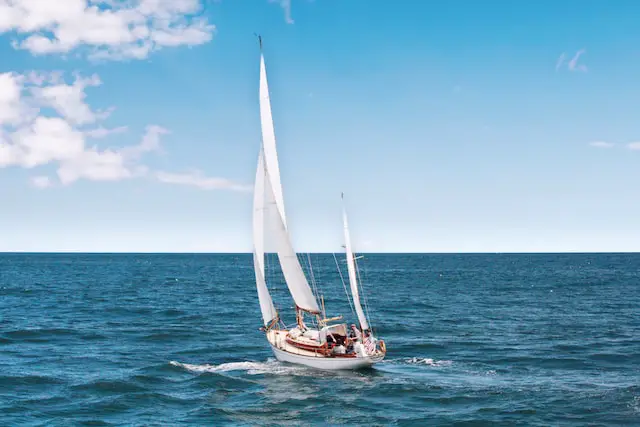
Boatgroot is reader-supported. When you buy through links on our site, we may earn an affiliate commission.
Crossing boats is a tricky situation that requires extraordinary attention from both operators. One inch here or there, your vessel can sustain big damage while crossing another.
Unlike on the road, where there are designated rules and lines to follow, water is an unknown territory, and maneuvering a boat requires a deep understanding of rules, decision-making skills, and quick thinking. It is up to the boat operators to communicate and work together to ensure a safe crossing.
Today, we are discussing what actions a sailboat operator does when crossing a PWC (Personal Watercraft). These two types of watercraft have varying sizes, shapes, and modes of operation, with a PWC typically requiring a rider such as a jet ski or water scooter.
Let’s move further and talk about the topic in detail.
Crossing Paths With Another Boat? What To Expect
| Determine the size and speed of other boats | This will help you understand which vessel has the right of way and how much room you need to give the other boat. |
| Speed and distance | Slow down or alter your course to avoid a close encounter, and always maintain a safe distance between your boat and the other vessel. |
| Communication | Use your radio, horn, or hand signals to make your intentions clear and ensure that both boats are aware of each other’s presence and course. |
| Local rules | The International Regulations for Preventing Collisions at Sea outline specific rules that govern the right of way in different situations. Follow these rules as closely as possible. |
| Bigger and quicker boats | Larger boats have the right of way over smaller vessels, while faster boats may require more room to maneuver. |
| Signals and flags | Other boats may display signals or flags that indicate their intended course or maneuvers. Be aware of these to help you predict their movements. |
| Be prepared to take action | If the other boat changes course suddenly or poses a hazard, be prepared to take evasive action to avoid a collision. |
| Be aware of the surroundings | Keep an eye out for other boats, swimmers, buoys, and other obstacles that could affect your course or pose a hazard. |
What Should Boat Operators Do?
Navigating a sailboat and PWC through each other can be challenging due to their contrasting features, mainly their size, and speed. Sailboats are generally larger and slower than PWC, which can make them difficult to operate, less maneuverable, and more susceptible to collisions. In contrast, PWC are fast-moving water crafts that can cause operators to lose situational awareness and increase their risk of accidents.
To avoid this situation, it is crucial for sailboat operators to take precautions when approaching a PWC head-on. Let’s take a look at some essential factors to consider before taking appropriate actions.
Navigation Skills
The primary step in approaching a PWC head-on with a sailboat is maintaining a safe distance and promptly reducing speed. Sailboats can be difficult to maneuver due to their size and shape, and reducing speed provides additional time to evaluate the situation and make informed decisions when crossing paths with other vessels.
| Slowing down | Always reduce your speed to allow more time to react to any changes in the PWC’s course. |
| Altering course | Operators must alter their course to avoid a collision with the PWC. They should maneuver to the left or right, depending on the direction a PWC is traveling. |
| Staying alert | Be alert and vigilant, scanning the water for other vessels and obstacles. |
Please refer to this video to learn more about navigation rules and skills:
The Importance of Communication
Effective communication between sailboat operators and PWC operators is key to avoiding collisions. Sailboat operators should use visual and audible signals to alert PWC operators of their presence and intention to avoid a collision. Some effective communication methods include:
1. Make Noise/Use Horn or Whistle
Sailboat operators should sound a horn or whistle to alert PWC operators of their presence.
2. Hand Signals
Hand signals should be used to communicate the intentions and position to PWC operators. For example, pointing to the left or right can indicate which direction the sailboat is turning. You can also use hand gestures to ask other vessels to stop or make way for you.
3. Communication Channels
Sailboat operators can connect with PWC operators nearby via a VHF radio or other communication devices. Channel 16 is the international hailing and distress frequency to establish contact and communicate their intentions.
Local Rules and Regulations
Before entering a remote location, it is essential to contact the local marine authorities to learn about the regulations governing the area. These rules are designed to promote vessel safety and ensure that all boaters comply with local waterway regulations. In the United States, the Coast Guard Navigation Rules COLREGS establish regulations for safe navigation and collision, as well as guidelines for crossing and overtaking.
Here are some important rules to remember:
| Rule 14 | Approaching Head-on | Operators should alter the course to starboard to avoid a collision with a PWC approaching head-on. |
| Rule 13 | Overtaking | Always keep clear of PWCs and maintain a safe speed when overtaking them from behind. |
| Rule 8 | Avoid Collision | Operators must take early and substantial action to avoid a collision with any other vessel, including PWCs. |
Here is a small video guide that will make things more clear for you:
This article provides guidance on the appropriate measures to take when approaching a PWC head-on. Approaching another vessel at sea is akin to approaching an unmarked intersection on the road, requiring adherence to specific guidelines to prevent collisions. To avoid accidents, it is necessary to follow basic regulations. In this case, the sailboat operator should maintain their current speed and course while the PWC should maneuver to avoid the sailboat, given its limited maneuverability.
LEAVE A REPLY Cancel reply
Save my name, email, and website in this browser for the next time I comment.

When Can Navigation Rules Be Overlooked – A Thorough Guide

White Buoy With an Orange Square and Black Lettering Meaning

When Returning From Open Sea and You See a Red Buoy,...

Which Safety Precaution Should Be Taken First by a Boat Operator...

What Should You Do if You See a Buoy With Red...
- Terms & Conditions
- Cookie Policy
Sailboat vs. PWC Head-On: Navigating the Waters with Confidence
- by Brandon Thompson
- October 22, 2023
Are you an avid sailor or PWC enthusiast? If so, you’ve probably encountered the thrilling, yet potentially challenging, situation of approaching another vessel head-on. Whether you’re steering a sailboat or a personal watercraft (PWC), knowing how to navigate this scenario is crucial for ensuring a safe and smooth journey on the water.
In this comprehensive blog post, we’ll delve into the rules and best practices for sailboats and PWCs when they meet head-on. We’ll address common questions, such as which vessel has the right of way, which side to pass on, and how to ensure a collision-free encounter. So, buckle up and prepare to gain valuable insights that will enhance your boating adventures in 2023 and beyond.
But wait, there’s more! To make it easier for you to find the specific information you need, we’ve included a list of keywords at the beginning of this post. So, whether you’re wondering about the stand-on vessel, the correct horn signals , or actions to take during an unexpected mishap, we’ve got you covered.
So, without further ado, let’s embark on this educational journey and discover what sailboats and PWCs should do when they find themselves face to face in the vastness of the open waters.

What Should a Sailboat Do When Approaching a PWC Head-On
Understand the pirates of the pwc:.
Ahoy, fellow sailors! As you navigate the vast waters on your majestic sailboat, you may encounter a peculiar vessel known as a Personal Watercraft (PWC), or as we like to call them, Pirates of the Water Currents. Now, these Pirates may seem like they just escaped from a high-energy rock concert on wheels, but fear not! With a dash of wit and a sprinkle of sailing wisdom, you can smoothly sail past them without any mishap.
Mind Your Starboard Side, Matey!
Arr, Captain! When a swashbuckling PWC comes hurtling towards your noble sailboat right on your starboard side, it’s time to take action. Stand tall and stay on course, as per maritime rules, they are required to yield to you. Keep a watchful eye and prepare for sudden maneuvers by these Pirates of the Water Currents. You never know when they might decide to recreate their favorite scene from “The Fast and the Furious” right in front of you!
Steer Clear and Show ‘Em Ye Colors!
Avast, sailors! If a PWC comes charging directly at ye head-on, it’s time to batten down the hatches and steer clear. Take evasive action by turning your sailboat to the side, allowing the speedy Pirates to pass by safely. As you make your move, don’t forget to display ye colors! No, we don’t mean your latest fashion statement; we mean using your navigational lights to communicate with these Pirates. Illuminate your starboard light, indicating you’re keeping to the right, and watch them whiz by with envy.
Speak Their Language, But Keep it Polite:
Arriving at the Pirate-infested waters where the PWCs rule their aquatic kingdom, it’s essential to learn their peculiar language. No, we’re not going to teach you how to say “Ahoy, matey” or “Shiver me timbers!” Instead, we’ll enlighten you on using horn signals. When you spot a PWC operating erratically or not following proper maritime etiquette, give a friendly (but stern) toot of your horn. It’s their cue to shape up and navigate responsibly. Remember, diplomacy in the high seas is always fashionable!
A Pirates’ Cove for Safety:
Ahoy, adventurous sailors! If you find yourself in a close quarters situation with a nimble PWC, it’s time to seek refuge in a nearby cove or marina. Don’t panic; this is just a temporary tactic to ensure the safety of all on board. Once anchored in the cove, engage in pleasant conversation with the Pirates, and kindly ask them to keep a respectful distance while passing by. A little laughter, a little charm, and a whole lot of sea wisdom can go a long way in ensuring a harmonious coexistence between sailboats and PWCs.
In the End, the Seas Belong to All:
As we bid adieu to the Pirates of the Water Currents, remember that the seas belong to all passionate sailors, no matter their vessel choice. By navigating with caution, respect, and a healthy dose of humor, we can peacefully coexist and embrace the diverse ways we explore the vast blue beyond. So, set sail, my friends, and may fair winds guide you towards unforgettable adventures on the high seas!

FAQ: What should a sailboat do when approaching a PWC head-on
Which way will the pwc go.
When a sailboat is approaching a personal watercraft (PWC) head-on, it is important to anticipate the PWC’s movement. PWCs generally have greater maneuverability than sailboats due to their smaller size and agility. However, it is difficult to predict the exact path the PWC will take. Therefore, it is crucial for the sailboat operator to remain attentive, be prepared to make corrections if necessary, and maintain a safe distance.
When a sailboat is approaching a powerboat, which one is the give-way vessel? The slower boat or the powerboat
According to maritime regulations , the give-way vessel is the sailboat, which is typically slower than a powerboat. The powerboat has the right of way and should maintain its course and speed. It is the responsibility of the sailboat operator to give way by altering their course, so as to avoid a potential collision .
What should you do when approaching another vessel head-on
When approaching another vessel head-on, both operators should take necessary precautions to prevent a collision. Communicating through sound signals, slowing down, and altering course are essential actions to avoid potential accidents. The operator of each vessel must be vigilant, make eye contact if possible, and use good judgment to ensure the safety of both parties.
Do you pass on port or starboard
When passing another vessel head-on, it is customary to steer to starboard, which means passing on the right side. This allows for a clear and predictable course of action, as each vessel will steer to their own starboard side, maintaining distance and avoiding a collision.
Who is the give-way vessel in a head-on situation
In a head-on situation, the give-way vessel is typically the sailboat or slower vessel. The faster boat, whether it’s a powerboat or a PWC, should maintain its course and speed while the slower boat maneuvers to avoid a potential collision.
What should a sailboat operator do when approaching a PWC head-on
When a sailboat is approaching a PWC head-on, the sailboat operator should be prepared to give way and alter their course if necessary. Maintaining a safe distance, monitoring the movement of the PWC, and displaying navigational courtesy are crucial to ensure a safe boating experience for all parties involved.
What should the operator of two powered vessels do when they approach each other in a head-on situation
When two powered vessels are approaching each other head-on, both operators have a responsibility to avoid a collision. This involves maintaining a safe distance, reducing speed, and altering course if needed. Effective communication through sound signals and keeping a close eye on one another are additional precautions that can contribute to a safe passage.
When a sailboat is approaching a powerboat, which one is the give-way vessel
In a scenario where a sailboat is approaching a powerboat, the powerboat is considered the give-way vessel. Sailboats generally have the right of way, and powerboats must yield by altering their course and speed to avoid any potential danger.
When reboarding a personal watercraft (PWC) after a fall, how should it be rolled
When reboarding a PWC after a fall, it is important to roll it in the direction that allows the operator to regain control and safely re-enter the watercraft. Depending on the situation and the PWC’s design, rolling it towards the operator’s side or toward the opposite side may be necessary. Prior knowledge of the specific PWC’s reboarding process is advisable to ensure a smooth and safe reentry.
What do you do when you meet a sailboat head-on
Meeting a sailboat head-on requires both operators to exercise caution and take appropriate steps to avoid a collision. It is essential to communicate through sound signals and maintain a close watch on one another. Steering to starboard, passing on the right side, is a common practice in order to safely navigate around each other.
When a powerboat meets a sailboat, who has the right of way
When a powerboat meets a sailboat, the sailboat generally has the right of way. However, it is crucial to note that each situation is unique and may require different actions. The operator of the powerboat should exercise caution, maintain a safe distance, and be prepared to give way as necessary to avoid any potential hazards.
When approaching another boat, assume that, according to the navigation rules, you are the stand-on boat. Which exception to the rules means you must give way
While it is generally advisable to assume you are the stand-on boat when approaching another vessel, there is an important exception to this rule. If you are in a head-on situation where both vessels have a risk of collision, the stand-on boat must give way by altering its course and avoiding any potential danger. Prioritizing safety over right of way in this scenario is crucial.
What action would you take if you encounter a head-on situation
If you encounter a head-on situation while boating, immediate action is necessary to prevent a collision. Both vessels should reduce speed, alter course, and signal intentions to communicate with each other. It is important to remain calm, use sound judgment, and prioritize the safety of everyone involved.
When approaching another boat head-on, you should steer to starboard and sound how many horn blasts
When approaching another boat head-on, it is customary to steer to starboard and sound two short blasts on the horn. This audible signal alerts the other vessel of your intentions and indicates that you are yielding and passing on their starboard side. Proper communication through horn blasts enhances safety and reduces the risk of misunderstandings while maneuvering.
What is the first action required of a boat operator involved in a boating accident
In the event of a boating accident, the first action required of a boat operator is to assess the situation and ensure the safety of everyone involved. Immediately provide any necessary medical aid or assistance to those in need. Once safety has been addressed, it is essential to contact the appropriate authorities and report the incident as required by local regulations.
When should a sailing vessel keep out of the way of a power-driven vessel
A sailing vessel should keep out of the way of a power-driven vessel when they are in close proximity or approaching each other. The power-driven vessel has limitations in maneuverability compared to a sailing vessel, and it is important for the sailboat to give way and allow the power-driven vessel to maintain its course and speed. This ensures a safe and seamless passage for both vessels.
What action should be taken if a motorboat and PWC are approaching head-on
When a motorboat and a personal watercraft (PWC) are approaching each other head-on, both operators should take immediate action to avoid a potential collision. Communicating through sound signals, altering course, and reducing speed are essential steps to ensure a safe passage. Maintaining a safe distance and remaining attentive are key factors in preventing accidents between these two types of vessels.
What happens if two ships are approaching each other head-on
When two ships are approaching each other head-on, it is crucial for both vessels’ operators to follow marine regulations and take appropriate steps to avoid a collision. The operators must communicate through sound signals, alter course as needed, and maintain a safe distance. This ensures the safety of the crew, passengers, and both vessels involved.
What should a motorboat do when approaching a sailboat head-on
When a motorboat is approaching a sailboat head-on, the motorboat operator should take necessary precautions to avoid a collision. The motorboat should yield to the sailboat, which typically has the right of way. Altering course, reducing speed, and maintaining a safe distance are essential actions to ensure a smooth passage and prevent any potential accidents.
What action should be taken when a sailboat is about to cross paths with a PWC
When a sailboat is about to cross paths with a personal watercraft (PWC), it is important for both operators to communicate and be aware of each other’s presence. The sailboat has the right of way in most cases, but it is advisable for both vessels to reduce speed and alter their course, if necessary, to avoid any chance of collision. Maintaining a safe distance and practicing good seamanship contribute to a safe and enjoyable boating experience.
Is Rule 14 (head-on situation) applicable to sailing vessels
Yes, Rule 14, which addresses head-on situations, is applicable to sailing vessels. Sailing vessels, like any other type of vessel, must follow this rule to prevent collisions. The concept of giving way and maintaining a safe distance to avoid any potential accidents remains the same for sailing vessels in head-on situations.
What should a powerboat do when about to cross paths with a sailboat
When a powerboat is about to cross paths with a sailboat, the powerboat should take appropriate actions to ensure a safe passage. In most cases, the sailboat has the right of way, so the powerboat operator should yield by altering their course and reducing speed. Effective communication through sound signals and maintaining a safe distance are important in preventing any conflicts and ensuring the safety of both vessels.
When a powerboat is approaching the rear of a sailboat, the powerboat is the stand-on vessel
No, when a powerboat is approaching the rear of a sailboat, the powerboat is not automatically the stand-on vessel. The concept of stand-on and give-way vessels depends on the specific situation and navigational rules in effect. Generally, the powerboat should give way to the sailboat and maintain a safe distance to avoid hazards and potential collisions.
When approaching another boat head-on, you should steer to starboard
Yes, when approaching another boat head-on, it is customary to steer to starboard or the right side. This practice allows both vessels to pass on their respective starboard sides, maintaining a clear path and reducing the risk of collision. By steering to starboard, boaters establish a predictable and safe navigation method when encountering other vessels.
- personal watercraft
- potential collision
- pwc enthusiast
- sailing wisdom
- vessel head-on
Brandon Thompson
Can i get blackheads on my nipples understanding the nitty-gritties of nipple health, does geo shatter genshin: exploring the potential of geo in elemental reactions, you may also like, unveiling the mystery behind green lantern’s yellow weakness.
- by Donna Gonzalez
- October 8, 2023
Demystifying Code Green: Unraveling the Secrets of Target’s Colorful Safety System
The single most significant factor that contributes to suicide.
- by Willie Wilson
- October 30, 2023
Where do Sagittarius like to be Touched?
- by Travis Heath
- November 3, 2023
Is the WCX or Dragoon Better? A Comprehensive Comparison
- by Laura Rodriguez
- October 19, 2023
Is Biofreeze Good for Nerve Pain?
- October 7, 2023
- All Collection
- Accessories
- Gauge Accessories
- Cameras & Night Vision
- GPS - Fishfinder Combos
- Transducers
- Transducer Accessories
- Network Cables & Modules
- Instruments
- Safety Light
- Medical Kits
- Fume Detectors
- Personal Locator Beacons
- Personal Flotation Device
- Waterproof Bags & Cases
- Man Overboard Device
- Immersion/Dry/Work Suits
- Flotation Coats/Pants
- Hull Protection
- Steering System
- Display Mounts
- Trolling Motors
- Hatch Lifts
- Windshield Wipers
- Rod Holders
- Shore Power
- Deck/Galley
- Adhesive/Sealants
- Bow Thrusters
- Winter Covers
- Fuel Systems
- Antifouling
- Jack Plates
- Radar/TV Mounts
- Fuel Management
- Security Systems
- Engine Controls
- Non-Skid Paint
- Trolling Motor Accessories
- Trim Tab Accessories
- Busbars, Connectors & Insulators
- Meters & Monitoring
- Fuse Blocks & Fuses
- Circuit Breakers
- Battery Management
- Battery Chargers
- Battery Isolators
- Electrical Panels
- Charger/Inverter Combos
- Switches & Accessories
- DC to DC Converters
- Wire Management
- Solar Panels
- Alternators
- Fender Covers
- Docking Accessories
- Anchoring Accessories
- Windlass Accessories
- Rope & Chain
- Bumpers/Guards
- Fender Accessories
- Piling Caps
- Mooring Whips
- Antenna Mounts & Accessories
- Mobile Broadband
- Cellular Amplifiers
- Loud Hailers
- Satellite Telephone
- Single Side Band
- VHF - Handheld
- Hailer Horns
- Instruments MN & I -1 Gauges Accessories Autopilots Radars Gauge Accessories MN & I -2 Cameras & Night Vision GPS - Fishfinder Combos Transducers Transducer Accessories Network Cables & Modules Instruments
- Safety Marine Safety -01 EPIRBS Safety Light Medical Kits Fume Detectors Personal Locator Beacons Marine Safety -02 Accessories Personal Flotation Device Waterproof Bags & Cases Man Overboard Device Immersion/Dry/Work Suits Flotation Coats/Pants
- Boat Parts BA & P -01 Hull Protection Steering System Display Mounts Trolling Motors Hatch Lifts Propeller Horns BA & P -02 Windshield Wipers Rod Holders Shore Power Deck/Galley Trim Tabs Seating Mirrors BA & P -03 Adhesive/Sealants Bow Thrusters Winter Covers Fuel Systems Antifouling Jack Plates Anodes BA & P -04 Radar/TV Mounts Fuel Management Security Systems Engine Controls Non-Skid Paint Tools BA & P -05 Trolling Motor Accessories Trim Tab Accessories Gauge Accessories Accessories Cleaning Gauges
- Electrical E&N -01 Busbars, Connectors & Insulators Meters & Monitoring Fuse Blocks & Fuses Circuit Breakers E&N -02 Battery Management Battery Chargers Battery Isolators Electrical Panels E&N -03 Charger/Inverter Combos Switches & Accessories DC to DC Converters Inverters E&N -04 Wire Management Shore Power Terminals Wire E&N -05 Solar Panels Accessories Alternators Tools
- Docking A & D -1 Fender Covers Anchors Docking Accessories Anchoring Accessories Windlass Accessories A & D -2 Rope & Chain Windlasses Fenders Bumpers/Guards Buoys Fender Accessories A & D -3 Ladders Dock Line Piling Caps Cleats Mooring Whips
- Communication Com -01 Antenna Mounts & Accessories Mobile Broadband Cellular Amplifiers Loud Hailers CB Radios Com -02 Satellite Telephone Single Side Band VHF - Handheld Hailer Horns Accessories Antenna
What Should a Sailboat Operator Do When Approaching a PWC Head-On?

In the world of boating, it's essential for all operators to have a solid understanding of navigation rules and safety protocols. This is especially true when it comes to encounters between different types of watercraft, such as sailboats and personal watercraft (PWCs). In this article, we will explore the necessary steps that a sailboat operator should take when approaching a PWC head-on, ensuring the safety of everyone involved.
Understanding the Basics of Sailboat and PWC Operations
Before delving into the specific procedures, it's important to have a clear understanding of the roles and key features of both sailboats and PWCs. Sailboats rely on wind power to propel them forward , utilizing a combination of sails and rudder for steering. On the other hand, PWCs are motorized watercraft that are typically smaller and faster, offering exciting and agile experiences on the water.
Sailboats have a rich history that dates back thousands of years. From ancient civilizations to modern times, sailboats have been used for transportation, exploration, and leisure. The art of sailing requires a deep understanding of the wind and its effects on the sails. Sailors must learn to harness the power of the wind and use it to their advantage, adjusting the sails to catch the most favorable gusts. It's a skill that requires practice, patience, and a keen sense of observation.
On the other hand, PWCs are a relatively recent addition to the world of watercraft. They were first introduced in the 1960s and quickly gained popularity due to their speed and maneuverability. PWCs are powered by an internal combustion engine, which allows them to reach high speeds and perform thrilling maneuvers. They have become a staple in water sports and recreational activities, attracting adrenaline junkies and thrill-seekers from all over the world.
The Role of a Sailboat Operator
A sailboat operator is responsible for navigating the vessel, adjusting the sails, and ensuring the safety of all passengers on board. They must have a thorough understanding of the rules and regulations of maritime navigation, as well as the ability to anticipate potential risks and make quick decisions to mitigate them.
Operating a sailboat requires a combination of technical knowledge and practical skills. Sailors must be familiar with the different parts of the boat, such as the mast, boom, and rigging. They must also know how to read nautical charts, use navigational instruments, and interpret weather forecasts . Additionally, sailboat operators must be well-versed in the principles of right-of-way and be able to communicate effectively with other vessels on the water.
Furthermore, sailboat operators must have a strong understanding of the physics behind sailing. They need to know how to trim the sails to optimize their performance and maintain the boat's balance. They must also be able to adjust the rudder to steer the boat in the desired direction. It's a delicate dance between wind, water, and sail, and the sailboat operator must be in tune with all these elements to navigate successfully.
Key Features of a Personal Watercraft (PWC)
A PWC is designed for one to three people and is typically maneuvered by a person seated or standing on top of it. They are known for their speed and agility, making them a popular choice for recreational activities such as water skiing and wakeboarding. It's important for sailboat operators to recognize the capabilities and limitations of PWCs when sharing the water with them.
PWCs come in various shapes and sizes, but they all share a few common features. They are usually made of lightweight materials such as fiberglass or plastic, which allows them to glide smoothly over the water's surface. PWCs are also equipped with powerful engines that provide the necessary thrust to propel them forward. Some models even have advanced features such as adjustable trim systems and electronic throttle control, which enhance their performance and handling.
When operating a PWC, riders must wear personal flotation devices (PFDs) to ensure their safety in case of an accident. They must also be aware of their surroundings and follow the rules and regulations set by local authorities. PWC operators should avoid crowded areas and maintain a safe distance from other vessels, including sailboats. It's crucial for both sailboat operators and PWC riders to respect each other's space and share the water responsibly .
The Importance of Maritime Rules and Regulations
When it comes to ensuring the safety of all watercraft operators and passengers, adhering to established rules and regulations is paramount. Understanding and following these rules promotes order, minimizes risk, and allows for smoother interactions between vessels.
Maritime rules and regulations are put in place to protect the lives and property of those who navigate the vast oceans, lakes, and rivers. They serve as a guide for watercraft operators, providing them with a set of standards to follow to ensure safe and responsible navigation.
One of the most important aspects of maritime rules and regulations is the prevention of collisions. By establishing right-of-way priorities and maintaining safe distances, these rules help to reduce the risk of accidents on the water. Sailboat operators, in particular, must be well-versed in these rules to navigate the waterways confidently.
General Navigation Rules for Watercrafts
Regardless of the type of vessel, there are general navigation rules that apply to all watercraft operators. These rules are intended to prevent collisions, maintain safe distances, and establish right-of-way priorities. Sailboat operators must be familiar with these rules to navigate the waterways confidently.
One such rule is the requirement to maintain a proper lookout at all times. This means constantly scanning the surrounding area for other vessels, navigational hazards, and any changes in weather conditions. By doing so, operators can take the necessary actions to avoid potential dangers and ensure the safety of everyone on board.
Another important rule is the obligation to operate at a safe speed. This not only helps to prevent collisions but also allows for better maneuverability in case of unexpected situations. Sailboats, with their reliance on wind power, must be particularly mindful of their speed and adjust accordingly to maintain control .
In addition to these rules, watercraft operators are also required to display the appropriate navigation lights during specific times and conditions. These lights serve as a visual indication of the vessel's position , direction, and status, allowing other operators to make informed decisions and avoid potential collisions.
Specific Regulations for Sailboats and PWCs
While general navigation rules apply to all watercraft, there are specific regulations that sailboat operators and PWC riders must be aware of. These regulations outline the responsibilities and requirements unique to each type of vessel, ensuring a harmonious coexistence on the water.
For sailboats, one such regulation is the requirement to give way to vessels not under sail, such as powerboats. This rule recognizes the limited maneuverability of sailboats and ensures that they yield to vessels that have more control over their movement. By doing so, sailboat operators can avoid potential collisions and maintain a safe distance from other watercraft.
On the other hand, PWC riders must adhere to regulations that govern their specific type of vessel. These regulations often include restrictions on speed, distance from shore, and the use of personal flotation devices. By following these rules, PWC riders can enjoy their watercraft safely and responsibly, without endangering themselves or others.
It is worth noting that maritime rules and regulations are not static. They are continuously reviewed and updated to adapt to changing conditions and advancements in technology. Watercraft operators must stay informed about any changes to these rules to ensure compliance and maintain a high level of safety on the water.
Identifying a Head-On Approach
Recognizing a head-on approach is crucial for sailboat operators who want to take proactive measures to ensure the safety of all involved. Being able to identify visual indicators and effectively use radar for detecting approaching vessels allows operators to respond appropriately in a timely manner.
When out on the open water, sailboat operators must remain vigilant and aware of their surroundings. One of the most important skills they must possess is the ability to identify a head-on approach. This is when a sailboat and another vessel, such as a personal watercraft (PWC), are on a direct collision course. The consequences of a head-on collision can be disastrous, so it is essential to be able to recognize the signs and take immediate action.
Visual Indicators of a Head-On Approach
When a sailboat and a PWC are on a direct collision course, certain visual cues can help give early warnings. These cues include the constantly converging paths of the vessels, the lack of course changes from the approaching vessel, and the absence of any yielding signals.
Imagine you are sailing peacefully on a beautiful sunny day when you notice a PWC approaching from a distance. As the PWC gets closer, you start to notice that it is not altering its course, and its path seems to be converging with yours. This is a clear visual indicator of a head-on approach. Additionally, if the approaching vessel does not display any yielding signals, such as slowing down or changing direction, it further confirms the potential danger.
It is important for sailboat operators to remain calm and focused when they identify these visual indicators. Panic can lead to poor decision-making, so maintaining a clear mind is crucial. By recognizing these signs early on, operators can take proactive measures to avoid a collision and ensure the safety of everyone on board.
Using Radar for Detecting Approaching Vessels
While visual indicators are useful, using onboard radar systems adds an extra layer of safety. Radar allows sailboat operators to detect and track approaching vessels, even in low visibility conditions or at night. It's crucial to understand how to interpret radar signals and adjust the settings to ensure accurate results.
Radar technology has revolutionized the way sailboat operators navigate the open waters. By emitting radio waves and analyzing the signals that bounce back, radar systems can provide valuable information about the position, speed, and direction of other vessels in the vicinity. This is especially helpful when visibility is limited due to fog, darkness, or heavy rain.
When using radar to detect approaching vessels, sailboat operators must familiarize themselves with the various features and settings of their radar system. This includes understanding how to adjust the range, gain, and clutter controls to optimize the detection of other vessels while minimizing false readings. Additionally, operators should be aware of the different radar display modes available, such as relative motion and true motion, which can aid in interpreting the information provided by the radar system.
By combining visual indicators with radar technology, sailboat operators can significantly enhance their ability to detect and respond to a head-on approach. This comprehensive approach to situational awareness ensures that operators can make informed decisions and take appropriate action to avoid potential collisions.
Steps to Take When Approaching a PWC Head-On
Once a sailboat operator recognizes a head-on approach, taking immediate action is crucial. Following these steps will help mitigate the risk of collision and ensure the safety of everyone involved.
Slowing Down and Assessing the Situation
The first step is to reduce the speed of the sailboat to increase maneuverability and create a larger reaction time window. Slowing down allows the operator to carefully assess the situation and determine the best course of action based on the speed, distance, and intentions of the approaching PWC.
Making the Right-of-Way Decision
In a head-on situation, the right-of-way rules dictate that both the sailboat and the PWC must alter their courses to starboard, which means turning right. However, in practice, there are instances where the sailboat has limited maneuverability due to its size and the available wind. In such cases, it becomes the responsibility of the PWC operator to take evasive action.
Safety Measures to Consider
Ensuring the safety of everyone on board any vessel should always be a top priority. Sailboat operators must take necessary precautions and equip themselves with safety measures to handle unexpected situations effectively.
The Role of Life Jackets and Safety Equipment
Life jackets are essential safety equipment for all individuals on board. Sailboat operators must ensure that all passengers, including themselves, are wearing properly fitted life jackets. Additionally, having other safety equipment, such as fire extinguishers, flares, and a first aid kit, readily available is crucial for quick response in case of emergencies.
Emergency Procedures for Sailboat Operators
Despite proactive measures, emergencies can still occur. Sailboat operators should be knowledgeable about emergency procedures, such as man overboard drills and distress signal protocols. Preparing for emergencies and practicing response plans increases the chances of a safe outcome.
In conclusion, sailboat operators must possess comprehensive knowledge of navigation rules, recognize head-on approaches, and take appropriate actions when encountering PWCs. Prioritizing safety, employing effective communication and navigation techniques, and equipping oneself with essential safety measures are essential to creating a safe and enjoyable experience for everyone on the water.
Marine Parts and Supplies
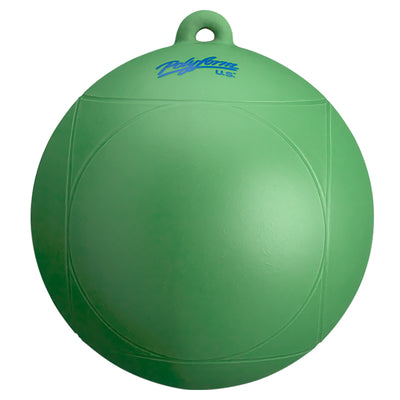
TOP TRENDING ↝

Your browser is out-of-date! You must upgrade to a different browser to experience this site.
Course Outline
- The Rules of the Road
- Important Definitions
- Required Sound Signaling Equipment
- Sounding Off - When and How to Use Sound Signals
- The Rule of Responsibility
- Proper Lookout
- Rules for Avoiding Collisions
- Overtaking a Power-Driven Vessel

Approaching a Power-Driven Vessel Head On
- Approaching a Power-Driven Vessel From the Side
- Approaching a Sailing Vessel
- Approaching Another Sailing Vessel
- Operating in Heavy Traffic
- Operating in Narrow Channels
- Operating in Darkness - Part 1
- Operating in Darkness - Part 2
- Operating in Restricted Visibility
- Visual Distress Signals
- Marine Distress Signals - Anytime Use
- Marine Distress Signals - Daytime Use
- Pyrotechnic Visual Distress Signals
- Non-Pyrotechnic Visual Distress Signals
- Pyrotechnic Equipment Storage and Handling
- Number of Required Visual Distress Signals
- Aids to Navigation
- Uniform State Waterways Marking System - Part 1
- Uniform State Waterways Marking System - Part 2
- Intercoastal Waterway Markers
- Western River Markers
- Docking Mooring
- Anchoring - Part 1
- Anchoring - Part 2
This site requires JavaScript. Your browser either doesn’t support JavaScript or you have it turned off.
For this page to function correctly, please enable JavaScript and then refresh the page.
Port-to-Port
Neither power-driven vessel A nor power-driven vessel B gives way or stands on in a head-on encounter. Therefore, some communication is needed between vessels A and B.

The most common response in a head-on meeting between power-driven vessels is to signal an intention to pass port-to-port. This action is initiated by one of the vessels sounding one short blast.
In short, vessel A must blow one short blast, indicating its intention to pass port-to-port, and then alters its course to starboard. Vessel B must return one short blast—to indicate agreement and understanding—and alter its course to starboard, thereby, leaving room on each vessel's port side for passing.
Starboard-to-Starboard
If it is not possible to pass port-to-port due to an obstruction or shoreline, a starboard-to-starboard pass should be signaled with two short blasts.
In short, vessel A must blow two short blasts, indicating its intention to pass starboard-to-starboard, and alter its course to port. Vessel B must return two short blasts to indicate agreement and understanding and alter its course to port, thereby, leaving room on each vessel's starboard side for passing.
- 2024 BOAT BUYERS GUIDE
- Email Newsletters
- Boat of the Year
- 2024 Freshwater Boat and Gear Buyers Guide
- 2024 Boat Buyers Guide
- 2024 Water Sports Boat Buyers Guide
- 2024 Pontoon Boat Buyers Guide
- Cruising Boats
- Pontoon Boats
- Fishing Boats
- Personal Watercraft
- Water Sports
- Boat Walkthroughs
- What To Look For
- Watersports Favorites Spring 2022
- Boating Lab
- Boating Safety
- Ultimate Boating Giveaway

Right-of-Way Rules for Boaters
- By Jeff Hemmel
- April 20, 2022
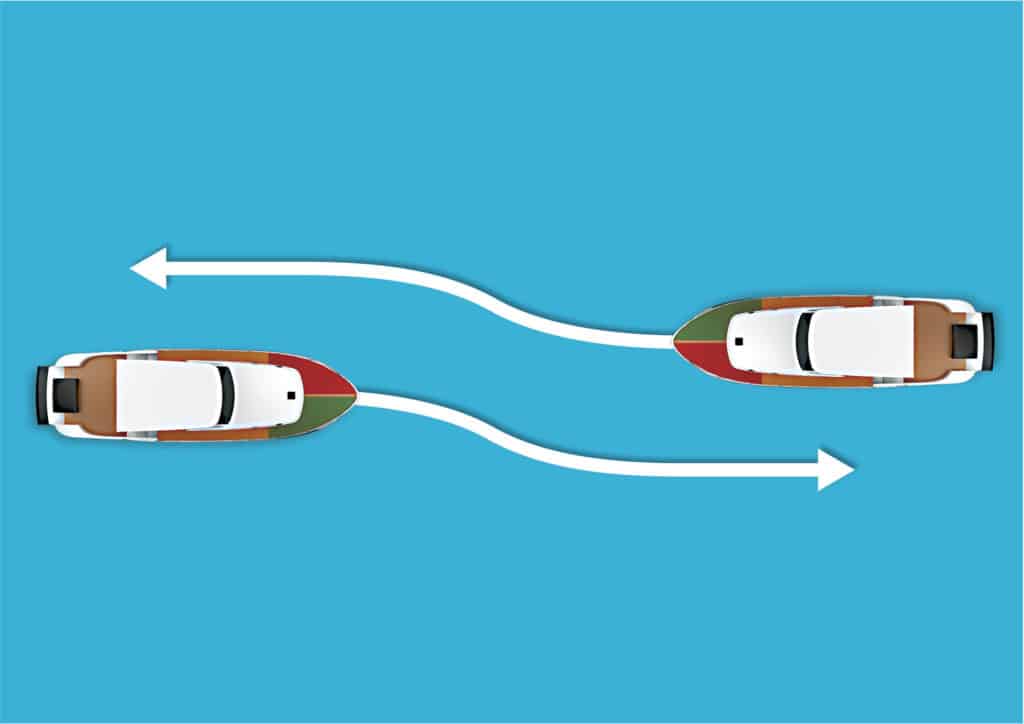
There is no right of way on the water. Every boater is obligated to do what is required to avoid collision. In any meeting of boats, one is deemed the stand-on vessel and the other the give-way vessel. The rules of the road explain the situation more completely and can be learned in a boating safety course. This article serves as a refresher and a reminder on how to handle some common meeting scenarios.
While more common in a channel or narrow pass, head-to-head meetings can happen anywhere on the water. When encountering an oncoming boat head-on, the rule is simple: Each boat is a give-way or burdened vessel and should stay to its right, altering course to starboard and allowing each craft to pass to the port (left) side of the other boat.
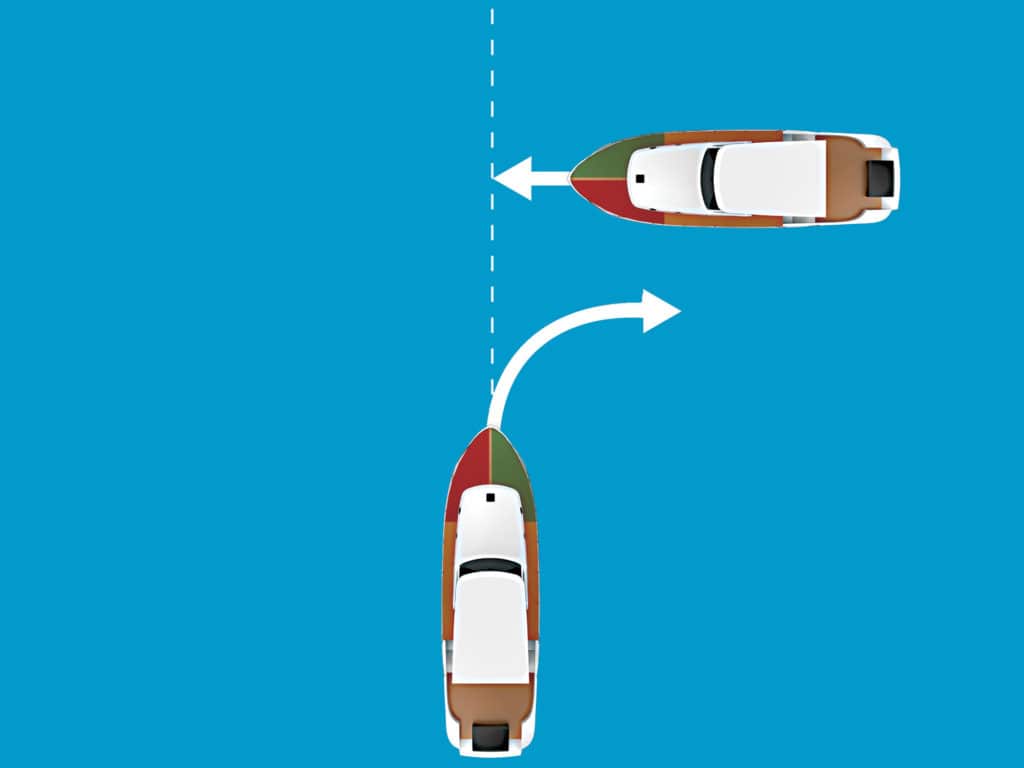
If the other boat is to your starboard (right), it’s considered the stand-on or privileged vessel and is obligated to maintain course and speed. Your boat is the give-way vessel and is obligated to slow or alter course to pass behind it, ideally. If the boat intersecting your path is to port (left), it’s the give-way vessel. It’s obligated to yield while you’re obligated to maintain course and speed.
When overtaking another boat, keep in mind that the other boat is the stand-on vessel and yours is the give-way vessel. Your first move? Determine to which side of that craft is the safest to pass. Consider oncoming traffic, waterway markers, obstacles, or even bends in the channel. Once you have a clear path with good forward visibility, increase your speed enough so that you can safely overtake the other vessel, giving the craft a wide berth.
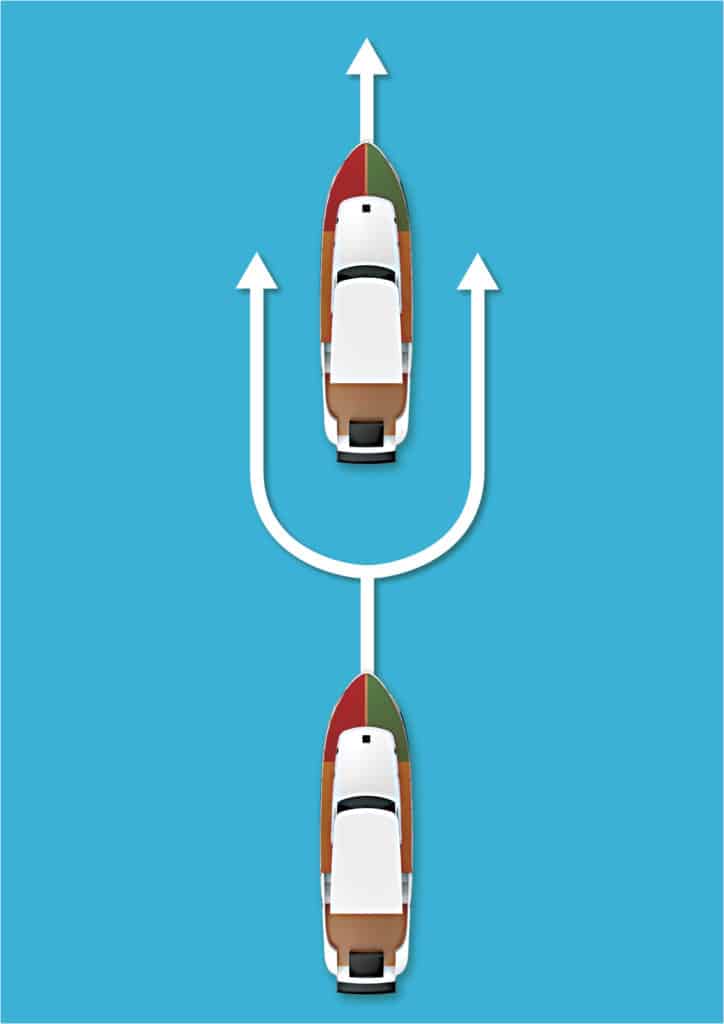
Encountering Kayaks, Sailboats, Etc.
Some vessels will almost always be the stand-on boat, and you must yield no matter the scenario, unless doing so will create an unsafe situation. Typically, this list includes paddlecraft and sailboats not under power, but it also includes larger craft, like ships or freighters. Realize these craft are not as maneuverable as most powerboats and, as such, the powerboat is deemed the give-way vessel.
Read Next: Boating Navigation Basics
When the Other Guy Doesn’t Know the Rules
No matter if you are the stand-on or give-way vessel, always be prepared in case the other boater doesn’t respond as you expect. Operate defensively, and be ready to yield, slow speed or change course to avoid any potentially dangerous situation. A good tip? Give other boaters plenty of space—100 feet or more—to allow enough time and distance to properly react and avoid an accident.
Know Your Colors
Do you know how to handle these scenarios at night, when you can’t see another boat, let alone determine its direction? Know your colors. Boats are required to display a green light to starboard (right) and a red light to port (left) at their bow, and most boats must display a single all-around white light at the stern. This combination of lights will help you determine which direction a boat is moving and if it’s likely to cross your path.
- More: Boating Safety , How-To , May 2022 , Seamanship
More How To

On Board With: Monique Richter
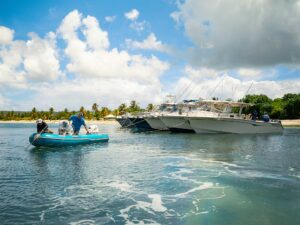
Grady-White Pulls off Its Largest Raft-up Ever in Vieques, Puerto Rico
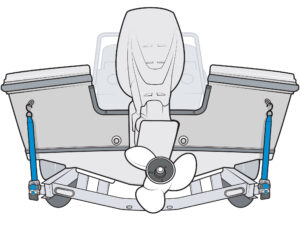
Installing Retractable Transom Straps
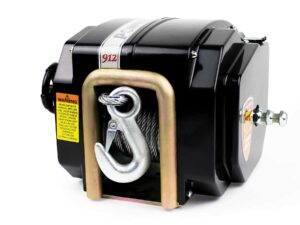
How to Choose a Trailer Winch
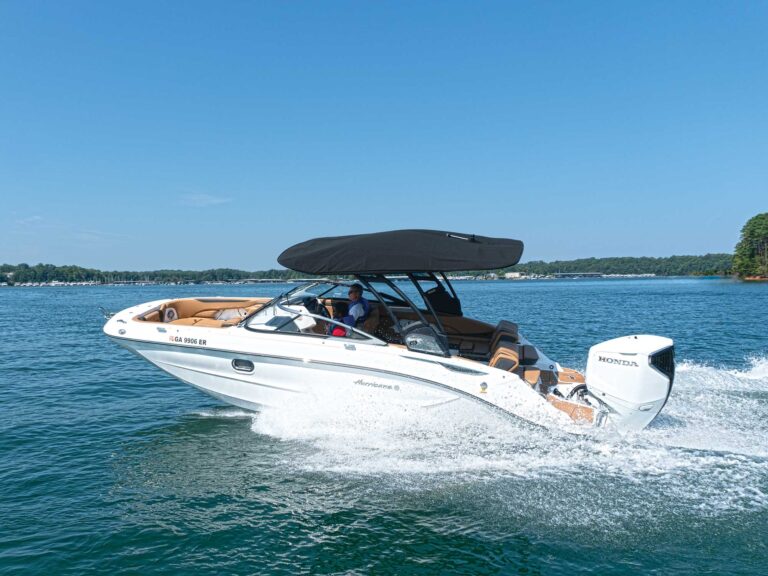
Boat Test: 2024 Hurricane SunDeck 2600 OB
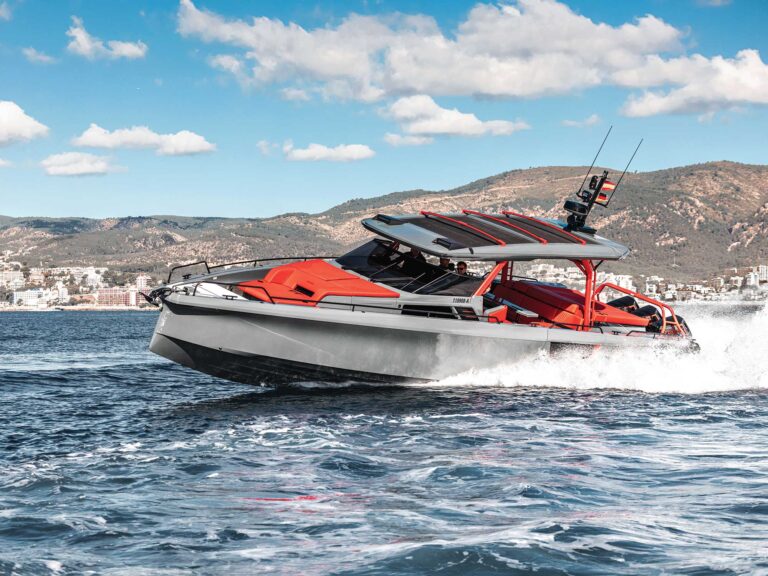
Boat Test: 2024 Brabus Shadow 1200 Sun-Top
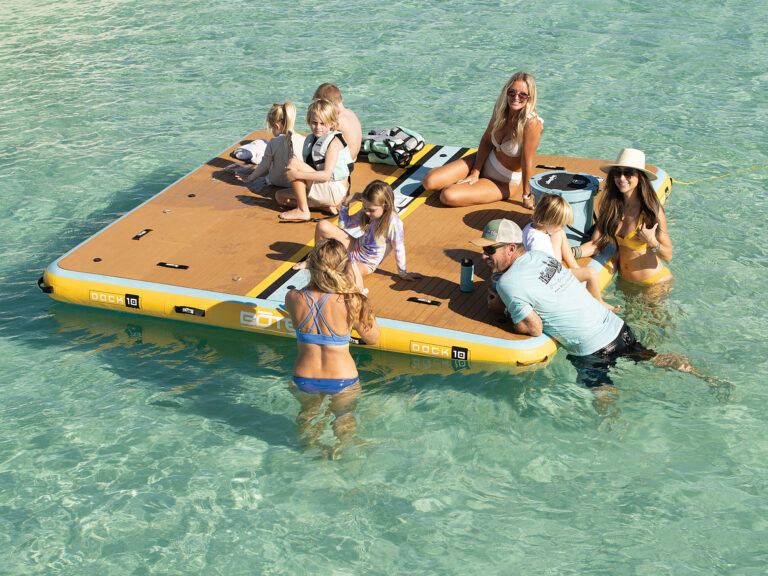
Inflatable Water Mats for Boaters
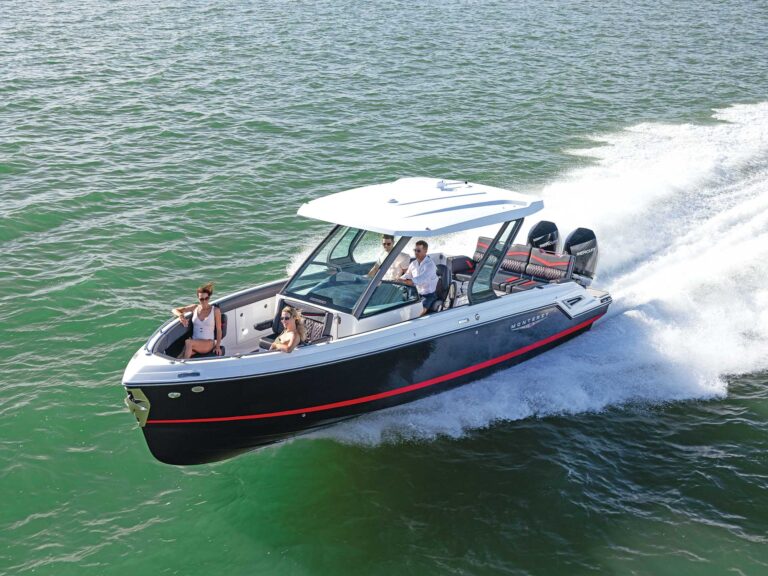
Boat Test: 2024 Monterey Elite 30

- Digital Edition
- Customer Service
- Privacy Policy
- Terms of Use
- Cruising World
- Sailing World
- Salt Water Sportsman
- Sport Fishing
- Wakeboarding
Many products featured on this site were editorially chosen. Boating may receive financial compensation for products purchased through this site.
Copyright © 2024 Boating Firecrown . All rights reserved. Reproduction in whole or in part without permission is prohibited.
What should the operators of two powered vessels do that approach each other in a head on situation? Boat Test Guide
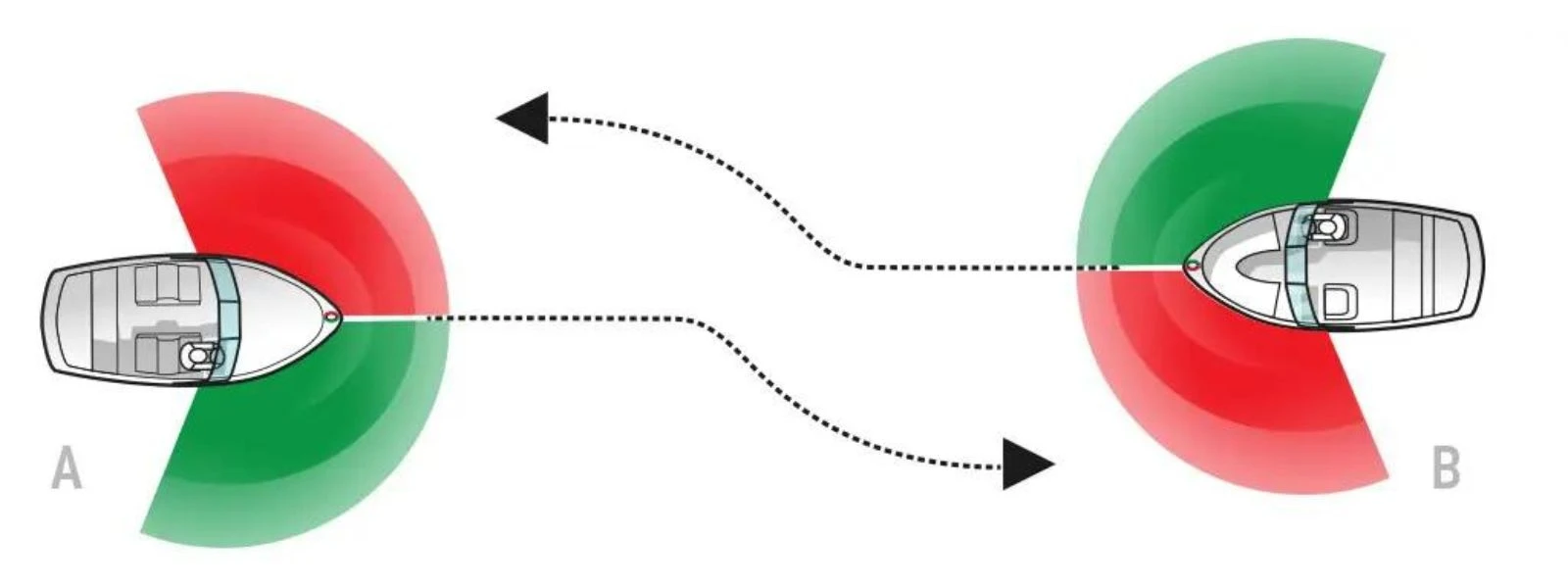
Image courtesy of BOATsmart
What should the operators of two powered vessels do that approach each other in a head on situation? Check out our boating test prep guide!
If you’re preparing for your boat licensing test, one important thing that you will have to know regarding boat safety is understanding what the operators of two powered vessels do that approach each other in a head on situation .
One question commonly seen on boating tests goes over “What should the operators of two powered vessels do that approach each other in a head on situation”. There are rules that every operator must follow and the action a vessel operator should take when encountering another vessel depends on the answers to two questions.
What should the operators of two powered vessels do that approach each other in a head on situation?
Two boats are operating in the same general area. who is responsible for avoiding a collision.
- A motorboat and a PWC are meeting head-on – Which one is the stand-on vessel?
One boat is overtaking another. Which boat must give way?
Who is responsible for avoiding a collision between two boats, two boats are operating near each other. which is the boat that must maintain its course and speed, what should the operator of a stand-on vessel do when encountering a give-way vessel, what should the operator of a give-way vessel do to avoid colliding with a stand-on vessel, what should the operators of a pwc and a motorboat do when approaching head-on, a motorboat is crossing paths with a pwc, what action should be taken, a pwc is overtaking another vessel which vessel must give way, tips for preparing for your boating test:, check out our other study guides for boating test questions, getting certified: passing your boat exam.
When two powered vessels approach each other in a head-on situation, both operators should:
- Alter their course to starboard (right)
- Pass each other port (left) side to port (left) side.
This maneuver reduces the risk of collision by creating a predictable and safe passing arrangement. Additionally, both operators should maintain a safe speed and keep a vigilant lookout for other vessels to ensure a smooth and uneventful passage.
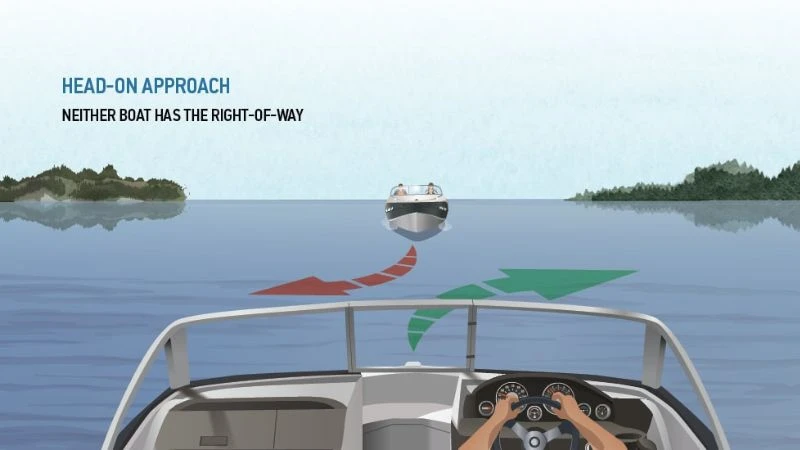
There are rules that every operator must follow when encountering other vessels. Two terms help explain these rules.
- Give-way vessel: The vessel that is required to take early and substantial action to keep away from other vessels by stopping, slowing down, or changing course. Giving-way should avoid crossing in front of other vessels or changing course and speed in a way that’s large enough to be apparent to the other vessel. It’s important to avoid a series of small changes in course or speed.
- Stand-on vessel: The vessel that must maintain its course and speed unless it becomes apparent that the give-way vessel is not taking appropriate action. If action is necessary, the stand-on vessel should avoid turning toward the give-way vessel or crossing in front of it.
When two boats are operating in the same general area, both operators are responsible for avoiding a collision. The right-of way is determined by answering two questions:
- How are the two vessels propelled?
- Two power-driven vessels
- Two sailing vessels
- A power-driven vessel and a sailing vessel
- How are the two vessels approaching one another?
- Meeting head-on: A vessel operator sees another vessel ahead or nearly ahead
- Paths that cross: Two vessels are on crossing paths so as to involve risk of collision
- Overtaking: A vessel is coming upon another vessel from behind or nearly behind the other vessel
Ultimately, it’s a shared responsibility to maintain a proper lookout, follow navigational rules, and take evasive action if necessary to prevent a collision. Each operator should stay alert, communicate clearly if needed, and maneuver their vessel safely to avoid any potential hazards or collisions.
A motorboat and a PWC are meeting head-on – Which one is the stand-on vessel?
In a head-on situation between a motorboat and a personal watercraft (PWC), the stand-on vessel would typically be the motorboat, assuming both vessels are under power. The motorboat should maintain its course and speed unless it becomes apparent that the PWC is not taking appropriate action.
When one boat is overtaking another, the boat being overtaken is generally considered the stand-on vessel, while the overtaking boat is the give-way vessel. The overtaking boat must maneuver in a way that ensures a safe and clear passage, keeping well clear of the boat being overtaken. It’s crucial for the overtaking boat to maintain a safe distance and avoid any actions that could potentially cause a collision or endanger the vessel being overtaken.
Both boat operators are responsible for avoiding a collision between two boats. It’s essential for both operators to maintain a proper lookout, follow navigational rules, and take necessary actions to prevent a collision. This includes maintaining safe speeds, being aware of the surrounding environment, communicating intentions clearly, and giving way when required by maritime rules and regulations. Ultimately, collision avoidance is a shared responsibility that requires vigilance and cooperation from all parties involved.
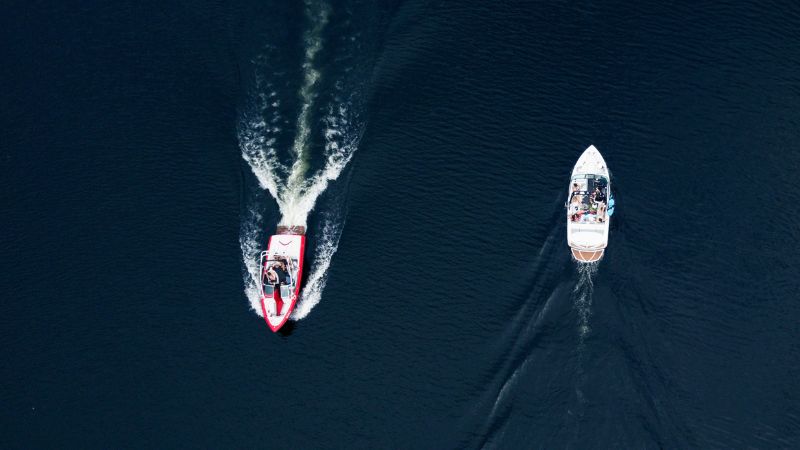
In maritime situations where two boats are operating near each other, the vessel that must maintain its course and speed is typically referred to as the “stand-on” vessel. This means that unless it becomes apparent that the other vessel is not taking appropriate action to avoid a collision, the stand-on vessel should continue on its current course and speed. However, it’s crucial for the stand-on vessel to remain vigilant and be prepared to take evasive action if necessary to prevent a collision.
When two boats are operating in the same general area, both operators are responsible for avoiding a collision. This shared responsibility ensures that both vessels take necessary actions to prevent an accident, adhering to the navigation rules and maintaining a proper lookout to ensure safe and prudent navigation.
When two powered vessels approach each other in a head-on situation, both operators should take early and substantial action to avoid a collision. They should both steer to starboard (right) to pass each other on the port (left) side. This is a standard practice under navigation rules to ensure safety and predictability on the water.
When encountering a give-way vessel, the operator of a stand-on vessel should maintain their course and speed, keeping a lookout for any changes in the give-way vessel’s actions. However, the stand-on vessel must be prepared to take evasive action if it becomes clear that the give-way vessel is not taking appropriate action to avoid a collision. The primary responsibility remains with the give-way vessel to navigate safely around the stand-on vessel.
The operator of a give-way vessel should take early and substantial action to avoid colliding with a stand-on vessel. This includes:
- Altering Course and Speed: Make a significant change in course and/or speed to clearly indicate to the stand-on vessel that you are taking action to avoid a collision.
- Communicate Intentions: Use sound signals, such as one short blast to indicate a turn to starboard (right) or two short blasts for a turn to port (left), if necessary, to communicate your intentions.
- Maintain a Safe Distance: Ensure that the maneuver leaves plenty of space between the two vessels, considering their speed, the sea state, and any navigational hazards.
- Monitor the Situation: Keep a constant lookout on the stand-on vessel to ensure that your actions are effective and that the stand-on vessel maintains its course and speed.
By following these steps, the operator of the give-way vessel can safely navigate around the stand-on vessel, reducing the risk of a collision.
When the operators of a PWC (Personal Watercraft) and a motorboat are approaching each other head-on, both should take the following actions to avoid a collision:
- Alter Course to Starboard: Both operators should alter their course to starboard (right) so that they pass port side to port side (left side to left side). This is the standard practice for head-on situations.
- Communicate Intentions: If necessary, use sound signals to communicate intentions. One short blast indicates a turn to starboard.
- Maintain a Safe Distance: Ensure that there is a safe distance between the two vessels as they pass each other.
- Keep a Lookout: Both operators should maintain a proper lookout by sight and hearing to avoid any obstacles or sudden changes in the other vessel’s course.
By following these actions, the risk of collision is minimized, and both vessels can navigate safely past each other.
When a motorboat is crossing paths with a personal watercraft (PWC), the motorboat is usually the “give-way” vessel, and the PWC is the “stand-on” vessel. As the give-way vessel, the motorboat should take early and substantial action to keep well away from the PWC by either slowing down, stopping, or altering its course. The PWC, as the stand-on vessel, should maintain its course and speed, unless it becomes clear that the motorboat is not taking appropriate action to avoid a collision. It’s essential for both operators to remain vigilant, communicate clearly, and take necessary maneuvers to ensure safety and prevent accidents.
When a personal watercraft (PWC) is overtaking another vessel, it is generally considered the give-way vessel. As such, it must maneuver to pass the other vessel safely, taking into account factors such as speed, distance, and the potential for collision. The vessel being overtaken is typically the stand-on vessel and should maintain its course and speed, allowing the PWC to pass safely. However, both operators should exercise caution, maintain awareness of their surroundings, and communicate effectively to avoid any potential collisions or accidents.
Preparing for your boating test? Studying for a boat test in Florida? Here are some helpful tips to get you ready:
- Study the Boating Regulations: Familiarize yourself with the rules and regulations specific to boating in your area. Understand navigation rules, safety requirements, and any local laws governing watercraft operation.
- Take a Boating Safety Course: Consider enrolling in a boating safety course to enhance your knowledge and skills. These courses cover essential topics such as navigation, emergency procedures, and legal requirements.
- Practice Safe Boating Techniques: Learn and practice essential boating maneuvers, including docking, anchoring, and navigating in different weather conditions. Familiarize yourself with basic safety equipment and how to use it effectively.
- Know Your Boat: If you own or plan to operate a specific type of boat, take the time to become familiar with its features, controls, and handling characteristics. Understanding your boat’s capabilities and limitations is essential for safe operation.
- Stay Updated: Keep abreast of any updates or changes to boating regulations and safety guidelines. Stay informed about local weather forecasts and waterway conditions before heading out on the water.
Remember, proper preparation is key to safe and enjoyable boating experiences. Whether you’re in Florida or anywhere else in the country, our excellent guides can help you get ready for your boating test and navigate the waters with confidence.
- How to dock a boat
- How to choose a marine gps app
- What Piece Of Equipment On A Boat Is Most Important In Preventing Propeller Strike Injuries ?
Start your safe boating journey at boat-ed.com . Their accredited courses, recognized by NASBLA, the National Association of State Boating Law Administrators, make learning boater safety, etiquette, and water rules easy and accessible. With interactive courses available on all devices, prioritize safety as you prepare for your exam.
You can get a preview of what this, and other questions may look like on a boating test by visiting our friends at Boat-Ed. Check out their study guide .
Related Posts

Australia Boat Navigation App On Apple Store And Google Play | Top Boat GPS App & Marine Navigation App in Australia

Which type of anchor should be used only for small, lightweight boats? | Anchor Types Boating Test Guide

What should you do before fueling your boat? Boat Fueling Boat Test Study Guide

When are you allowed to depart from the United States Coast Guard navigation rules? Boating Test Guide


Rules of the Road
Right of way rules.
Whenever you meet another boat, it’s like approaching an unmarked intersection in your car. Knowing a few, simple right of way rules will help you avoid a collision. Just as motorists must know what to do when approaching a four way stop, every crossing situation at sea is like approaching an unmarked intersection.
Because there are so many different types of boats and styles of boating, it is important to know what to expect when you come upon another vessel.
"Vessels" are anything that floats on the water that is used, or is capable of being used as a means of transportation on water. A log, a bathtub and many other things could be considered a vessel under the Navigation Rules. The Navigation Rules distinguish one vessel from another by both its design, and by its actions. This section covers maneuvering rules only.
There are other navigation rules that you are required to know. Sound Rules are covered under the Sound Signaling Equipment section. Light Rules are covered under the Navigation Light Equipment section.
The Rules of the Road are published by the U. S. Government Printing Office, and are available in any boating supply stores. Every boat owner should have a copy, but they are mandatory to be kept on vessels over 12 meters (39.4 feet) in length.
The Rules generally used in this course are Inland Rules, unless otherwise noted. There are small but important differences in the Rules depending on where you are operating your boat. It is your responsibility to know the Navigation Rules for your boating area.
- International Rules - Apply to all vessels upon the high seas and in all waters connected to them that are navigable by seagoing vessels.
- Inland Rules - Apply to all vessels upon the inland waters of the United States, and to vessels of the United States on the Canadian waters of the Great Lakes to the extent that there is no conflict with Canadian law. Certain inland waterways may have specific provisions that apply to certain vessels.
- Great Lakes - Includes the Great Lakes and their connecting and tributary waters including the Calumet River as far as the Thomas J. O'Brien Lock and Controlling Works (between mile 326 and 327), the Chicago River as far as the east side of the Ashland Avenue Bridge (between mile 321 and 322), and the Saint Lawrence River as far east as the lower exit of Saint Lambert Lock.
- Western Rivers - Includes the Mississippi River, its tributaries, South Pass, and Southwest Pass, to the navigational demarcation lines dividing the high seas from harbors, rivers, and other inland waters of the United States, and the Port Allen-Morgan City Alternate Route, and that part of the Atchafalaya River above its junction with the Port Allen-Morgan City Alternate Route including the Old River and the Red River.
Vessel Types
- Power Driven Vessel - Any vessel propelled by machinery. This includes any boat that has an engine. Sailboats are considered powerboats when they are being propelled by a motor - even if the sails are up.
- Sailing Vessel - Any vessel under sail alone. Remember, if being propelled by a motor, a sailboat is considered to be a powerboat.
- Vessels Engaged in Fishing - Means any vessel fishing with nets, lines, trawls or other fishing apparatus which restrict maneuverability, but does not include a vessel fishing with trolling lines or other fishing gear which doesn't restrict maneuverability. This means a shrimper out of Galveston is "engaged in fishing" Someone out trolling for stripers in their Grady-White is NOT considered to be engaged in fishing under the Rules.
- Seaplanes - Are any aircraft designed to operate on the water.
- Vessels Constrained by Draft - Means that a vessel can't deviate from a course/channel because they might run aground. A freighter in a narrow channel is an example of this. Note: This is for International waters only, not Inland.
- Vessels Restricted in Their Ability to Maneuver - Means a vessel that can't maneuver as required by the rules because of the size or operation of the vessel. A fishing vessel pulling in nets and a buoy tender placing a buoy are both examples of a vessel restricted in their ability to maneuver.
- Vessels not under Command - Any vessel that for some exceptional circumstance is unable to maneuver as required by the Rules, and is therefore unable to keep out of the way of another vessel. If Joe boater slips and knocks himself out, and can no longer steer--that's a vessel not under command. If the steering cable goes out, and you can't turn the boat, that's a vessel not under command. If the captain is not paying attention and hits another boat, that's negligence.
- Underway - Means that you are not anchored, moored, at the dock, or aground. If you are even drifting along, you are underway.
- Restricted Visibility - Means any condition such as fog, mist, falling snow, rain, or other similar causes that make it difficult to see other vessels. Losing your glasses is NOT restricted visibility.
Rule, Rule, Rule your Boat
It may seem as if you can do anything you want while you are on the water (You might also think that it looks as if everyone else is going crazy on the water). Boating on a crowded waterway can be scary! The good news is that there are rules to govern the action of each vessel. The bad news is that many vessel operators do not know the rules!
Not complying with the Rules - even if you don't know them, can get you in trouble on the water. Even if you think you are following the Rules, if there is something that you can do to avoid a collision - you must do it, even if you deviate from a different Navigation Rule.
It is your responsibility as the ship's captain to be aware of your surroundings at all times, and to operate your vessel in a safe manner. Caution may not be fun, but having an accident sure stinks.
The Rules state that every vessel shall use all available means appropriate to the prevailing conditions to determine if a risk of collision exists. If there is any doubt, such risk shall be deemed to exist.
Rules Explained
The Rules are designed to tell you what to do when you operate your vessel near other vessels. The purpose of the Rules of the Road is to help you avoid an accident--not to establish responsibility or liability if you get into an accident. - Remember, if you get into an accident, you can be held liable, even if you followed the Rules to the letter!
Your primary obligation is to operate in a safe manner. Under the Rules, there is no "right-of-way" like there is on a street. For most situations, Boats are called one of the following.
- Give-Way Vessel - If you are the Give-Way vessel, you must act as if the "stand-on" vessel has the right to keep going the way it is going. It is your responsibility to signal your intentions to the stand-on vessel, and it is your responsibility to maneuver your boat around the other in a safe manner. Also known as a "Burdened" vessel, as it has the burden of.
- Stand-On Vessel - If you are the Stand-On vessel, it is your responsibility to acknowledge the intended actions of the give-way vessel. You must also maintain your current course and speed until the give-way vessel passes, or you enter a dangerous situation.
Operator Responsibilities
In addition to the Rules, you have other responsibilities as the captain as well. You are responsible for the safety of everyone aboard your vessel at all times--and you have a responsibility to those with whom you are sharing the water.
- You must always operate at a safe controlled speed for the situation in which you are boating, and any legally mandated speed requirements that there may be, such as a slow/no wake zone.
- Take care to avoid careless, reckless or negligent boat operations--such as operating too closely to other vessels, boating under the influence, or operating at an unsafe speed for the given conditions.
- Steer clear of naval vessels, and other restricted facilities such as bridges, power plants and dams. New Homeland security measures require it, as does your safety! For more information, see the Homeland Security pages.
Finally, as a boater, you have a responsibility to all other boaters--and all others who enjoy the water--to be courteous and respectful of others. This means that you should always watch your boat noise (a legal requirement) avoid congested waters as much as possible, avoid disturbing wildlife and sea grasses, and look out for the safety and well being of other boaters by giving a hand to those in need.
The Pecking Order
There is a "pecking order" that can be used as a simplified memory aid to determine right of way for vessels of different types. Get very familiar with this list, as it is important to understand it thoroughly. The lower most vessel on the list is the give way vessel, and must stay out of the way of vessels that are higher on the list.
- Overtaken vessel (top priority)
- Vessels not under command
- Vessels restricted in their ability to maneuver
- Vessels constrained by draft
- Fishing vessels engaged in fishing, with gear deployed
- Sailing vessels
- Power driven vessels
Collision Avoidance
- Rules apply to vessels in all conditions of visibility. Rules are the same at night or in fog, for instance, as they are during a bright sunny day.
- Every vessel must maintain a proper look-out by sight and hearing at all times. Operator inattention and not having an adequate look out are a leading cause of accidents each year.
- Every vessel must proceed at a safe speed at all times. Several factors should be considered when determining safe speed, including but not limited to the state of visibility, traffic density, your vessel's maneuverability, with special reference to stopping distance and turning ability. At night, consider the presence of background lights such as those from shore, or from the back-scatter of your vessel's own lights. Consider also the state of wind, sea, and current, and the proximity of navigational hazards.
- The Rules specifically require that any action taken to avoid collision, if the circumstances allow, will be positive, made in ample time, and in keeping with good seamanship. Any changes in course or speed should be large enough to be readily apparent to the other vessel. This means that you should avoid last second changes in course, and you should avoid a small series of changes. Change direction early, and make a large turn.
Maneuvering
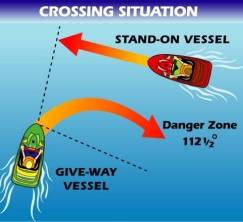
The main situations of collision risk are overtaking, meeting head-on, and crossing. When one of two vessels is to keep out of the way (give-way vessel), the other, the stand-on vessel, must maintain course and speed. The stand-on vessel must take avoiding action when it becomes apparent that the vessel required to give way is not taking appropriate action.
The Crossing Rule
Both International and Inland Rules state that when two power-driven vessels are crossing so as to involve risk of collision, the vessel which has the other on her starboard side (the give-way vessel) must keep out of the way.
As the give-way vessel it is your duty to avoid a collision. Typically, this means you must alter speed or direction to cross behind the other vessel (the stand-on vessel).
At night, if you see a red light crossing right-to-left in front of you, you need to change your course. If you see a green light crossing from left-to-right, you are the stand-on vessel, and should maintain course and speed.
The Meeting Situation
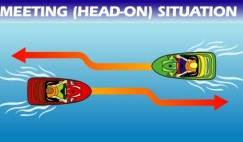
At times there may be some doubt whether the situation is a crossing or a head-on meeting. In case of doubt, you should assume that it is a meeting situation, in which neither vessel has a clear-cut "right-of-way," and each must act to avoid the other. Each vessel in a meeting situation must alter course to starboard so that each will pass on the port side of the other. At night, you will recognize a head-on meeting situation if you see both red and green side lights at the same time.
The Overtaking Situation
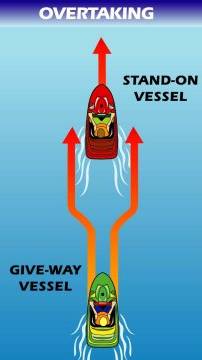
Any vessel overtaking any other vessel must keep out the way of the vessel being overtaken. The former is the give-way vessel and the latter is the stand-on vessel.
This rule applies even if the overtaking vessel is propelled by wind, oars, or rubber band paddlewheel.
A vessel is deemed to be overtaking when coming up with another vessel from a direction more than 22.5 degrees abaft (behind) her beam. This is the angle prescribed by the stern light.
At night, the overtaking vessel will see only the white stern light of the vessel being overtaken. If you see either side light, it is a crossing situation.
Operating in a Narrow Channel
First and foremost, you have to avoid larger vessels that can only travel in a channel. Even if your vessel is operating under the rules otherwise, you must give way to a boat that could potentially run aground or get into a collision if they left the channel.
Try and operate on the edge of the channel. Be extra cautious if you come to a bend in the waterway, and can't see traffic coming towards you.
You may sound a prolonged blast as a warning to traffic headed your way.
On the Great Lakes and Western River system, vessels going downstream are stand-on, vessels going up stream must give-way.
Potential Collision Situation
When the distance between two vessels decreases and the relative angle of the other vessel off the bow remains the same, then you will soon be trying to occupy the same spot in the water - a collision situation. Change course or reduce speed, even if you are the stand-on vessel.
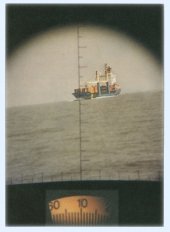
Conduct of Vessels During Periods of Restricted Visibilty
Operating a boat in areas or at times of restricted visibility requires extra concentration by the skipper and the lookout. You must operate your vessel at a speed at which you can identify and react to a situation and still have enough time to avoid a collision. This is especially important when vessels are no in sight of one another.
- Operate at a safe speed for the prevailing circumstances
- Have engines ready for immediate maneuvering - including reverse
- Don't rely on radar or other electronic imaging alone - use your buiilt in senses at all times
- Take avoiding actions early and provide ample time for the other vessels to maneuver
- Avoid sharp turns if being overtaken
- Always - you are in doubt, reduce your speed
- Every vessel shall at all times proceed at a safe speed
Other Rules
Whether under inland or international rules, power vessels must keep clear of sailing vessels in open waters. A sailboat with motor running is defined as a motor boat. The "pecking order" between sailing vessels is more complex. When two sailing are approaching one another so as to involve risk of collision, one of then shall keep out of the way of each other as follows.
- When each has the wind on a different side, the vessel which has the wind on the port side shall keep out of the way of the other.
- When both have the wind on the same side, the vessel which is to windward shall keep out of the way of the vessel which is to leeward.
- If a vessel with the wind on the port side sees a vessel to windward and cannot determine with certainty whether the other vessel has the wind on the port or the starboard side, she shall keep out of the way of the other.
- For the purposes of these rules the windward side shall be deemed to be the side opposite to that on which the mainsail is carried. On square-rigged vessels, it shall be deemed to be the side opposite to that on which the largest fore-and-aft sail is carried.
Now that you are familiar with "The Rules," go out and use them in passing, meeting, and crossing situations you find on the water. You will get many puzzled looks from inexperienced boaters with no training or testing.
Remember, if a collision does occur, your proper use of the correct signals and appropriate actions will win you points! But you know enough now to avoid a collision.
The navigation rules of the road contained in this course summarize basic navigation rules for which a boat operator is responsible. Additional and more in-depth rules apply regarding various types of waterways and operation in relation to commercial vessels and other watercraft. It is the responsibility of a boat operator to know and follow all the navigation rules.
For a complete listing of the navigation rules, refer to the document “Navigation Rules of the Road” published by the U.S. Coast Guard (COMDTINST 16672.2 Series) and available through the U.S. Government printing office or on the web here .
For state specific navigation requirements, refer to the state laws where you intend to boat.

The motorboat crossing the paths with a pwc: What actions to take?
Motorboat crossing the paths with a pwc.
Meeting another boat at sea is like approaching an unmarked intersection on the road.
Just like you have to follow a set of rules when you reach a cross-section, you must follow specific rules when approaching another boat at sea. You must follow simple rules to avoid a collision.
It is essential to know what to expect when you cross paths with another vessel. When in water, there are rules to govern the action of each vessel.
Unfortunately, many vessel operators do not know the rules. Not complying with regulations can get you in trouble.
While taking a Boat Ed or boating exam, you may come across the question –
If the motorboat is crossing the paths with a PWC, what action should be taken?
The correct answer to this question is – The vessel on the left (port) hand side should be the one to give way.
Now let us read some more information on the topic.

What is a PWC?
A personal watercraft (PWC) is a recreational watercraft that uses an inboard jet drive as its primary propulsion source.
Also known as a water scooter, a PWC is designed to be operated by a person sitting, standing, or kneeling on it.
What action to take if a motorboat crossing the paths with a pwc?
If a motorboat is crossing the paths with a PWC, the vessel on the port(left) side should give way.
A PWC should be treated like a motorboat. The rules are the same for a PWC or a motorboat.
If one vessel is crossing from the port side and the other one is crossing from the starboard side, then the one crossing from the port side is the make-way vessel and must alter its speed to avoid a collision.
The vessel on the starboard side must be given time to cross first.
Related Posts:
How fast do pontoon boats go?
Best pontoon boat anchors
Safety equipment list for a pontoon boat
Best pontoon boat accessories
Who has the right of way on the water?
Every captain should know the basics about what one has to do when two boats approach each other on the water. Here are some guidelines that you must understand and follow –
- Stand-on vessel – The boats that enjoy the right-of-way are known as ‘stand-on vessels.’ The stand-on vessel can maintain speed and direction while approaching other vessels.
If you are the stand-on vessel, it is your responsibility to acknowledge the give-way vessel’s intended actions. You must maintain your speed and current course until the give-way vessel passes or you enter a dangerous situation.
- Give-way vessel – The boats that are not given the right-of-way are known as give-way vessels. A give-way vessel should take early, substantial measures to steer clear of the stand-on vessel. You must stop, alter the speed and direction of your boat to avoid a collision. If you are the give-way vessel, it is your responsibility to signal your intentions to the stand-on craft. It is also your responsibility to maneuver your boat around the other in a safe manner.
Which is the stand on vessel motorboat or PWC?
PWCs are considered to be powerboats, and the same rules apply to them. In the scenario when a PWC encounters a motorboat, these are the rules of the road that come into play –
Meeting head-on
When a PWC and a motorboat are about to meet head-on, each vessel should move to the starboard side and pass in a normal traffic pattern (Pass with the other vessel to port.)
Vessels crossing paths
When a PWC wishes to cross the path of a motorboat, the direction of the approach is the factor that determines which one has the right of way. If a motorboat approaches you from the starboard side, it has the right of way.
You must take early and substantial action to avoid the other craft. If the other vessel approaches you from your port side, you have the right of way and must maintain your speed and course.
Overtaking another boat
Overtaking another boat is legal. You can do so either on the port side or on the starboard side.
According to the Collision Regulations, the vessel intending to overtake another one on the starboard side should sound one blast of the horn.
After ensuring the starboard side is clear, the boat that has to be overtaken should respond by sounding a single blast of the horn, indicating that the overtaking boat can proceed.
If the intention is to pass on the port side, the overtaking vessel has to sound two blasts on the horn to indicate their intent.
After ensuring that the port side is clear, the vessel that has to be overtaken should respond by sounding two blasts of the horn, indicating that the overtaking boat can proceed.
What should a powerboat do when crossing paths with a sailboat?
If you are operating a powerboat, you must always give way to a sailing vessel unless the sailing vessel is overtaking your vessel.
There is a pecking order that determines the right of way for vessels of different types. Understand this list and get familiar with it.
The vessels lower on the list are the give-way vessels and must stay out of the way of the boats that are higher on the list.
1. Overtaken vessel (top priority)
2. Vessels not under command
3. Vessels that are restricted in their ability to maneuver
4. Vessels that are constrained by draft
5. Fishing vessels that are engaged in fishing, with gear deployed
6. Sailing vessels
7. Power-driven vessels
What should a sailboat operator do when approaching a PWC head-on?
The sailboat operator should maintain its current speed and the current course as it is the stand-on craft.
The motorized PWC is the give-way craft, so it should maneuver to avoid the sailboat as the sailboat lacks maneuverability. On a head-to-head collision, both vessels should pass port to port.
What do you do if you are operating a motorboat that is being overtaken by a sailboat?
If you are operating a motorboat being overtaken by a sailboat, you should keep going as you are. The vessel that is being overtaken is always the stand-on vessel.
The vessel you are overtaking is the give-way vessel, regardless of whether it is a power-driven vessel or a sailboat.
Now, let’s look at some frequently asked questions related to PWC and what actions to when motorboat crossing the paths with a pwc.
Can you consider a PWC a boat?
The US Coast Guard classifies the PWC as a Class A Inboard Boat (a boat less than 16 feet in length).
They are designed to carry up to three persons and can be operated by a person sitting, standing, or kneeling on the watercraft.
A PWC does not look like a boat but is subjected to the same laws as a yacht, and all boating licenses also work the same way.
What are the legal requirements to operate a PWC?
The legal requirements to operate a PWC include –
- A person should be a minimum of 16 years of age to operate a PWC.
- You need to wear a personal floatation device to operate a PWC.
- If you want to ride in the dark, you will need to have navigational lights.
- All operators of personal watercraft must have a Boating Safety Education Certificate in their possession.
- All operators of PWC should adhere to boating law as violating these laws can have legal consequences.
Is it safe to ride PWC at night?
It is illegal to ride a PWC at night in most states in the US. In some states, it is allowed, but you have to have to correct navigational lights installed and turned on.
However, it is not safe to drive PWCs at night as the rider can get seriously hurt. The navigational lights of the PWC can confuse the other boats, especially from a distance.
A PWC can move fast and suddenly change direction, which can confuse the other boaters at night.
Are you required to wear a PFD on a PWC?
Each person on board a PWC must wear a US Coast Guard-approved wearable Type I, II, or III PFD.
How much distance should one PWC maintain from another PWC or boat?
A PWC should maintain a distance of 50 feet from any other boat, PWC, or jet ski. A PWC should maintain a similar distance from other people in the water, stationary platforms in the water, and shorelines.
What actions to take if a sailboat under sail is about to cross paths with a PWC?
If a sailboat under sail is about to cross paths with a PWC, the PWC should change its speed and course. The power-driven vessel is the give-way vessel, and the sailing vessel is the stand-on vessel.
If two boats are traveling on paths that will cross, what determines which boat is the give-way vessel?
The answer depends on these two factors –
1. How are the vessels propelled?
- Two power-driven vessels
- Two sailing vessels
- A power-driven vessel and a sailing vessel
2. How are the two vessels approaching one another?
- Meeting head-on – the vessel operator can see another vessel ahead.
- Paths that cross- this involves a risk of collision
- Overtaking – A vessel is trying to overtake another vessel from behind.
Final thoughts on the motorboat crossing the paths with a pwc
I hope you are now familiar with all the rules and laws regarding passing, crossing, and overtaking different vessels in the water.
In this post, we have tried to answer all your questions regarding PWCs, including what to do when the motorboat crossing the paths with a pwc. We hope you find this information helpful for your boating exams.
Related posts:
How to Run a Boat HIN / HULL ID Check Instantly
Where is the Best Place to Store a Fire Extinguisher on a Boat?
A boat is towing two skiers at the same time. How long should the tow lines be?
Can you ski behind a pontoon boat?
A motorboat and a PWC are meeting head-on Which one is the stand-on vessel?
Neither- Power vs Power
Add your answer:
A motorboat and PWC are meeting head on. Which one is the stand on vessel?
A motorboat and a PWC are meeting head-on. Which one is the stand-on vessel?
You are operating a motorboat What if your motorboat is being overtaken by a sailboat What should you do?
If you are operating a motorboat and your motorboat is being overtaken by a sailboat, you should maintain present course and speed. The vessel that is overtaking another vessel is the give-way vessel, regardless of whether it is a sailing vessel or a power-driven vessel. The vessel being overtaken is always the stand-on vessel.
What is a standon vessel?
Rule 17Action by stand on vessel(a) (i) Where one of two vessels is to keep out of the way, the other (The stand on vessel) shall keep her course and speed.Please refer to the link provided below.
A sailboat and a pwc are meeting headon which one is the stand on vessel?
Sailboat. A PWC, or personal watercraft, is the give way vessel to any sailboat. In the US, a PWC refers to any small powerboat less than 13 feet in length. As such, it is a powerboat and must give way to all sailboats.
You're operating a motorboat you hear one prolonged blast from the horn of another vessel what should you do?
You are operating a motorboat. You hear one prolonged blast from the horn of another vessel. What should you do?
What should a motor boat operator do when approaching a sailing vessel head on?
When approaching a sailing vessel head on, it is up to the motorboat to yield. The motorboat operator should swing wide as early as possible to stay well clear of the sailing vessel.
When a sailing vessel and a pwc are meeting head on which is the stand on vessel?
When a sailing vessel and a pwc are meeting head on the sailing vessel is the stand on vessel.
What should a motorboat operator do when approaching a sailing vessel head-on?
Do everything possible to avoid it. The motorboat operator would give way if boat is under sail but go by regular motorboat rules if he is under power.
If a sailboat and motorboat are both underway when is the sailboat the give way vessel?
Whenever a danger of collision exists.
If a sailboat and a motorboat are both underway when is the sailboat the give-way vessel?
If a sailboat and a motorboat are both underway when is a sailboat the give way vessel.
Top Categories


IMAGES
VIDEO
COMMENTS
Effective communication between sailboat operators and PWC operators is key to avoiding collisions. Sailboat operators should use visual and audible signals to alert PWC operators of their presence and intention to avoid a collision. Some effective communication methods include: 1. Make Noise/Use Horn or Whistle.
When out on the open water, sailboat operators must remain vigilant and aware of their surroundings. One of the most important skills they must possess is the ability to identify a head-on ...
What Should a Sailboat Do When Approaching a PWC Head-On Understand the Pirates of the PWC: Ahoy, fellow sailors! As you navigate the vast waters on your majestic sailboat, you may encounter a peculiar vessel known as a Personal Watercraft (PWC), or as we like to call them, Pirates of the Water Currents. Now, these Pirates may seem like they ...
PWC Encountering PWC. It is extremely important that a PWC encountering another PWC follow the same navigation rules that apply to motorboats or any other power-driven vessel. Most fatalities involving a PWC result from injuries caused by collisions and not from drowning. The operator and passengers ride on top of the PWC instead of down inside it.
The vessels are shown closer to each other than they should be when actually encountering another vessel on the water. Meeting Head-On: The power-driven vessel is the give-way vessel. The sailing vessel is the stand-on vessel. Paths That Cross: The power-driven vessel is the give-way vessel. The sailing vessel is the stand-on vessel. Overtaking ...
Steps to Take When Approaching a PWC Head-On Once a sailboat operator recognizes a head-on approach, taking immediate action is crucial. Following these steps will help mitigate the risk of collision and ensure the safety of everyone involved. Slowing Down and Assessing the Situation The first step is to reduce the speed of the sailboat to ...
Activity: Meeting Head-On—PWC vs. PWC. Parts of a PWC From a Side View and Operator's View. Activity: Casting Off With Wind or Current Toward the Dock. Casting Off With Wind or Current Away From the Dock. Activity: Casting Off With Wind or Current Away From the Dock. Activity: Docking With Wind or Current Toward the Dock.
Therefore, some communication is needed between vessels A and B. The most common response in a head-on meeting between power-driven vessels is to signal an intention to pass port-to-port. This action is initiated by one of the vessels sounding one short blast. In short, vessel A must blow one short blast, indicating its intention to pass port ...
Rules of the Road for Sailboats. Sailboats under sail have their own rules and rights of way over each other. The Windward Side of a sailboat is the side opposite to that on which the mainsail is carried. If the mainsail is over the Starboard Side of the sailboat, the Port Side is the Windward Side. If two sailboats have the wind on different ...
Meeting. While more common in a channel or narrow pass, head-to-head meetings can happen anywhere on the water. When encountering an oncoming boat head-on, the rule is simple: Each boat is a give-way or burdened vessel and should stay to its right, altering course to starboard and allowing each craft to pass to the port (left) side of the other ...
When a motorboat is crossing paths with a personal watercraft (PWC), the motorboat is usually the "give-way" vessel, and the PWC is the "stand-on" vessel. As the give-way vessel, the motorboat should take early and substantial action to keep well away from the PWC by either slowing down, stopping, or altering its course.
Meeting Head-On: PWC vs PWC. You are operating a PWC. You see another PWC coming head-on directly toward you. You're the PWC at the bottom of the screen, encountering another PWC.
Sailing Vessel - Any vessel under sail alone. Remember, if being propelled by a motor, a sailboat is considered to be a powerboat. ... The main situations of collision risk are overtaking, meeting head-on, and crossing. When one of two vessels is to keep out of the way (give-way vessel), the other, the stand-on vessel, must maintain course and ...
Study with Quizlet and memorize flashcards containing terms like What should the operator of powerboat A do if powerboat B begins to cross on the starboard (right) side? a. Speed up and maintain present course. b. Give way by slowing down and changing course. c. Turn sharply to port (left). d. Speed up to pass in front of powerboat B., A motorboat and a PWC are meeting head-on. Which one is ...
A sailboat and a PWC are meeting head-on. Which one is the stand-on vessel? Choose matching definition. sailboat. PWC. neither. both. Don't know? 9 of 20. Term. One boat is overtaking another. Which boat should stand on? Choose matching definition. the boat being overtaken. the boat creating the most wake. the faster boat. the larger boat.
In the scenario when a PWC encounters a motorboat, these are the rules of the road that come into play - Meeting head-on. When a PWC and a motorboat are about to meet head-on, each vessel should move to the starboard side and pass in a normal traffic pattern (Pass with the other vessel to port.) Vessels crossing paths
Meeting Head-On: PWC vs PWC. Which is the stand-on vessel? You're the PWC at the bottom of the screen, encountering another PWC. both PWCs; neither PWC; the other PWC;
A PWC, or personal watercraft, is the give way vessel to any sailboat. In the US, a PWC refers to any small powerboat less than 13 feet in length. As such, it is a powerboat and must give way to ...
After Fueling Your Boat; Video: Fueling Your Boat; Fueling a PWC; Prevent Running Out of Fuel; Topic 10: Trailering Your Boat. Choosing the Right Trailer and Towing Vehicle; The Towing Hitch; Trailer Safety Chains; Before Leaving Home With Your Boat and Trailer; On the Road With a Trailer; Launching Your Boat From a Trailer
Activity: Docking With Wind or Current Toward the Dock. Activity: Docking With Wind or Current Away From the Dock. Topic 3: Navigation Rules: Traffic Laws of the Waterways. Power-Driven Vessel Encountering Power-Driven Vessel. Animation: When You See a Red, a Green, and a White Light. When You See a Red and a Green Light But No White Light.
Responsibility to Environment: Keep Waterways Clean. Responsibility to Environment: Practice the Three Rs. Responsibility to Environment: Protect and Preserve. Responsibility to Environment: Avoid Toxic Products. Topic 2: Small Boats and Paddlecraft (Canoes, Kayaks, and Rafts) View Course Outline.
While Fueling Your Boat; After Fueling Your Boat; Video: Fueling Your Boat; Fueling a PWC; Prevent Running Out of Fuel; Topic 10: Trailering Your Boat. Choosing the Right Trailer and Towing Vehicle; The Towing Hitch; Trailer Safety Chains; Before Leaving Home With Your Boat and Trailer; On the Road With a Trailer; Launching Your Boat From a Trailer